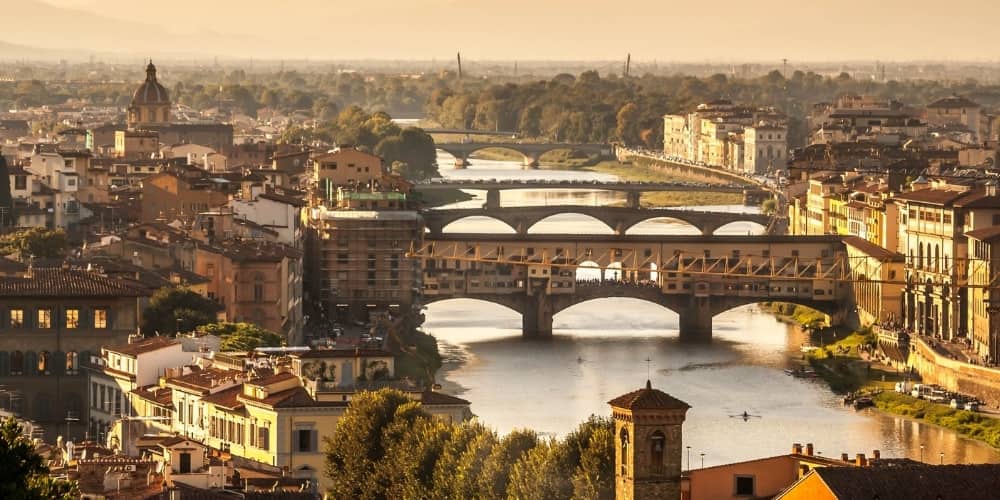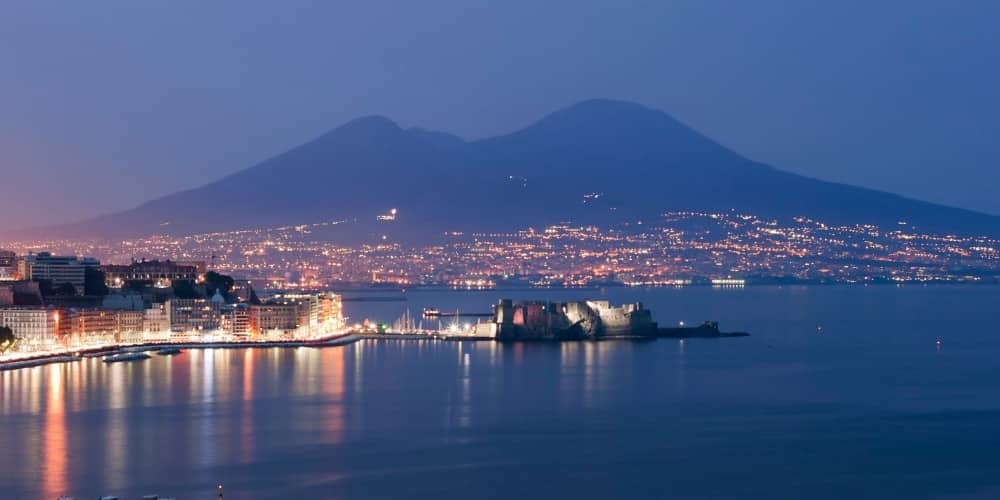
10. Pisa - region Toscana

Pisa is an unmissable destination... and not just for taking a photo of the famous leaning tower!
At Easter the weather is mild and Pisa is a great choice for a holiday of culture and outdoor walks. Start with a visit to Piazza del Duomo, with its fine monuments such as the Duomo, the Baptistery and the Leaning Tower of Pisa. The walk continues along the lungarni, streets that run along the Arno River and are home to important buildings, bridges and churches dating back to the Middle Ages.
Among the characteristic streets of the historical centre, among arcades, shops and cafés, you can admire historical buildings and important squares such as Piazza delle Vettovaglie, where the historical food market takes place and where you can find several taverns and wine bars to taste typical Pisan dishes. Pisa also offers a good choice of museums, including the Museo dell'Opera del Duomo, which houses an important collection of paintings and other works relating to the religious buildings in Piazza del Duomo. Another interesting museum is the Museo delle Sinopie. The Sinopias are the preparatory drafts of the frescoes.
Not to be missed, just a few minutes from the centre of Pisa, is the San Rossore Park, which was once the Medici family's estate and is now a nature reserve that reaches as far as the sea and offers countless routes for splendid nature walks.
9. Venice - region Veneto

Venice for its art and the beauty of its lagoon is an ideal destination at any time of the year. There are so many places to visit here. Stroll through canals, calli, piazzas, cross bridges, throw away your map and lose yourself in the beauty of La Serenissima.
Between one calle and another, stop at an osteria and try typical Venetian dishes such as baccalà mantecato and bigoli, accompanied by a good glass of wine. Spring is undoubtedly the right season to visit Murano, Burano and Torcello, the largest islands in the Venetian lagoon.
In Murano, famous for its traditional production of blown glass, among small canals and colourful houses, you will find many workshops and shops where you can buy various glass objects. Burano will amaze you with its characteristic colourful houses and centuries-old Venetian lace-making. Finally Torcello, with its houses, colonial-style restaurants and gardens, will take you back in time to another era. Don't leave Venice without taking a photo of the sunset over the lagoon!
8. Bari - region Puglia

Bari, the city of two faces, is a fascinating discovery. Strolling along the seafront, the largest in Italy, you will arrive in Bari vecchia, the ancient heart of the city, guardian of art, flavours and colours. Lanes, historic buildings, marvellous churches such as the Basilica of San Nicola, the Romanesque Basilica of San Gregorio, the Cathedral of San Sabino and the grand Norman-Swabian Castle built by Frederick II.
In the 19th-century Murattiano district, elegant palazzos such as the Petruzzelli Theatre, the Piccinni Theatre and Palazzo Fizzarotti line the streets. The city's underground area also contains rock-hewn churches and hypogea, such as the Temple of San Giorgio, the Madia Diana hypogeum and the 'Jewish' hypogeum.
In Bari, East and West come together and as you stroll through its alleyways you will also be guided and inspired by the smell of freshly baked pasta, bread and focaccia. In addition, in the surrounding area, there are many beautiful towns and villages to discover.
7. Genoa - region Liguria

Strolling around Genoa you can breathe in the history and tradition of the Genoese, the great sailors and merchants of the Mediterranean. A large part of its historical centre, declared a Unesco heritage site, with its narrow alleys called "caruggi", the tall houses, the noble palaces, every villa, park and fortification, reflects the charm of the ancient and great Genoese Maritime Republic.
There are many palaces to visit: Palazzo San Giorgio, completely frescoed, Palazzo della Nuova Borsa in Piazza De Ferrari and then Palazzo Ducale, one of the oldest, nowadays the seat of important artistic and cultural exhibitions. The area of the alleys, near the Porto Antico, is characteristic for its mixed architecture, Romanesque churches, classical and neoclassical palaces, buildings with oriental style architecture.
But Genoa is not only the historical centre. Thanks to the restoration of many existing buildings and the construction of new structures, the city has also given itself a modern face. In the Porto Antico area, we find the Aquarium, one of the largest in Europe, and the futuristic architecture of the Bolla and Bigo, designed by Renzo Piano.
With its 35 km of coastline, Genoa offers beautiful seaside walks and, to finish, in the capital of pesto, you can't miss tasting typical dishes and fish starters!
6. Verona - region Veneto

Verona, the city of love, art and culture, fascinates with its historic centre and historic quarters along the Adige River. From the central Piazza Bra you can admire the Arena di Verona and possibly enjoy its magical atmosphere during a musical performance. From here you can walk to Piazza Bra, Piazza Erbe and Juliet's house with its famous balcony.
Crossing the river Adige via Ponte Pietra, you can reach the Roman Theatre of Verona and the San Pietro hill, a suggestive and unmissable place for the wonderful view of the city and the river. Don't miss a stop in a typical trattoria for lunch with typical Veronese dishes and a good glass of Veneto wine!
In the surroundings of Verona, there are many interesting places to visit such as Lake Garda and its villages, the characteristic town of Valeggio sul Mincio, the Sigurtà park, and the characteristic sanctuary Madonna della Corona, clinging to Mount Baldo, suspended between heaven and earth.
5. Palermo - region Sicily

Palermo represents a unique cultural and artistic heritage that reflects the many cultures and souls that have passed through it over the centuries. We find the harmonious fusion of different cultures in the Arab-Norman style, a UNESCO World Heritage Site since 2015, and visible in seven of the city's religious and civic buildings, including the marvellous Palatine Chapel, the Royal Palace, the Cathedral and the church of Santa Maria dell'Ammiraglio or Martorana. The discovery of the historic centre starts from Piazza Villena, known as the four canti, where the two main streets of the centre meet: Via Maqueda and Via Vittorio Emanuele.
Strolling through the centre you will admire Piazza Pretoria with its famous fountain, the splendid Palermo Cathedral, the Massimo Theatre, the Martorana Church, many cafés, fine monuments and historic buildings until you reach Porta Felice facing the sea.
Take a stroll through the colours, sounds and flavours of Palermo's historic markets: Vuccirìa, Ballarò, il Capo and Borgo Vecchio. Lose yourself among the stalls selling fruit, vegetables, meat, fish and don't forget to try Palermo's street food. Palermo is one of the capitals of street food, so you must try the food in the markets, bars and squares: arancine, panelle, crocché, pani c'a meusa, sfincione, stigghiole, boiled octopus.... to name a few!
To relax, just a few kilometres from the city, there is Mondello with its beautiful Art Nouveau villas and crystal clear sea. Near Palermo, don't miss Monreale with its Arab-Norman cathedral and the wonderful village of Cefalù with its Arab-Norman cathedral and characteristic fishing village.
4. Florence - region Toscana

Florence is a treasure trove of art treasures unique in the world. There are many places of art and worship to visit, such as the Cathedral of Santa Maria del Fiore, the Baptistery, the Uffizi Gallery, the Bargello and the Accademia Gallery. And then the churches of Santa Maria Novella and Santa Croce, true art galleries, the Biblioteca Medicea Laurenziana, expression of Michelangelo's architectural genius, and the important museums and galleries of Palazzo Pitti.
In Florence, it is also beautiful just to walk through the streets of the historic centre, passing by Piazza della Signoria to reach the river Arno and the romantic Ponte Vecchio with its craft shops. The wonderful Boboli Gardens are also a great choice for a nice day out in an open-air museum.
Finally, reach the Church of San Miniato al Monte on the hill behind Piazzale Michelangelo and from here enjoy the wonderful view over Florence. To better organise your visit to the city, read our top 10 things to do in Florence.
3. Neaples - region Campania

Naples is undoubtedly one of the most enchanting cities in the Mediterranean and will surprise you with its colours and warmth. Apart from its beautiful landscapes with the imposing volcano Vesuvius and the 3 beautiful islands of Capri, Ischia and Procida in the distance, the city owes its fame to the charm of its old historic centre, a UNESCO World Heritage Site since 1995.
Naples is a lively city and a stroll through its streets reveals monuments and buildings from different historical eras. Taking "Spaccanapoli", the main street that divides the old city in two, you will find the Church of Gesù Nuovo, the Basilica of San Domenico Maggiore and finally the Cathedral. Don't miss the Monastery of Santa Chiara, with its beautiful cloister, the Basilica of San Lorenzo Maggiore, which preserves Greek and Roman remains, Piazza del Plebiscito and the four castles!
Breathe in the folklore and cheerfulness of its historical neighborhoods such as Sanità and Quartieri Spagnoli, stop for a coffee in Galleria Umberto I, stroll along the seafront and eat a good pizza! Around Naples, there are many wonderful places to visit: Sorrento, Positano, Amalfi, Pompeii and much more.
2. Milan - region Lombardia

Milan, the fashion capital and business centre, is the 'most European' city in the country. From the central Piazza del Duomo with its splendid gothic cathedral, a nice walk will take you to the Galleria Vittorio Emanuele with its historical shops, Piazza della Scala with its famous theatre and then the Sforzesco Castle with its beautiful park. Don't miss the Basilica of San Lorenzo with its columns and the basilica of Sant'Ambrogio, testimonies of Roman Milan.
Take a stroll through the elegant Brera district to the futuristic Piazza Gae Aulenti with its modern buildings, including the Bosco Verticale. The city's futuristic soul is also well represented by Citylife, a modern district that is the result of a new concept of urban spaces.
Finally, immerse yourself in Milan's nightlife with a stroll along the Navigli, the city's historic area full of trattorias, restaurants, pubs and bistros for a good aperitif or dinner! Milan will amaze you with its modern and historical soul and its countless attractions! Take a look at the 20 must-see attractions in Milan!
1. Rome - region Lazio

The Eternal City has been the centre of the world for centuries and remains as beautiful a destination as any in the world. Don't be in a hurry and take your time to admire the countless monuments and romantic views of the city.
There are many itineraries and routes to discover Rome. Start with the symbols of the city such as the Colosseum, St. Peter's Basilica and its square, the Sistine Chapel, Castel Sant'Angelo, the wonderful Trevi Fountain and Piazza di Spagna with its enchanting staircase. Stroll through the squares of the historic centre, enjoy the breathtaking views from Rome's panoramic terraces and savour Roman cuisine in a typical trattoria.
Walk along the Tiber and get lost in the alleys of Trastevere. Artists such as Michelangelo, Audrey Hepburn and Fellini have represented the beauty of this city through their art, and every time you visit Rome you can't help but be amazed by its immense historical, artistic and cultural heritage. Read our tips for organising your Roman holiday!
About the author
Written on 31/01/2022



Ilaria Capatti
North, south and centre: here are our recommendations on the top 10 destinations for Easter 2022 in Italy!